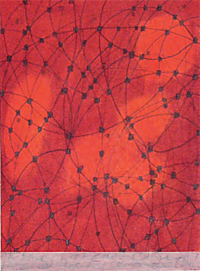One of the simplest yet most profound things attributed to the Buddha in the Pali canon is the general statement of interdependent origination:
When there is this, there is that,
When there is not this, there is not that.
When this arises, that arises.
When this ceases, that ceases.
(Samyutta Nikaya 12.37)

First and foremost, this statement expresses the importance of causation for the Buddha, who states very clearly that everything happens in causal, and therefore understandable, patterns. Nothing happens by chance. Nothing happens simply because a deity wills it. A famous short summary of this teaching is a verse that brought the Buddha’s two chief disciples to the dhamma: “Whatever things develop from a cause, the Buddha has declared both their cause and their cessation.” (Mahavagga 1.23)
Moreover, the general statement of causation is a formula that can be applied to almost anything. The demonstrative pronouns “this” and “that” stand for variables. We might just as well say, “When there is X, there is Y.” And this is just what the early texts go on to do. They state the formula with different words taking the place of the variables, yielding chains of related statements. These chains have been misinterpreted by modern readers to be linear causal sequences or “chains of events,” but the whole point of the doctrine is that multiple factors co-arise in each moment while mutually conditioning one another. The Pali term for this doctrine, paticca-samuppada, can be understood as referring to phenomena arising together (samuppada) while depending on one another (paticca,literally, “going back toward”). One image used in the text is of sheaths of reeds leaning against each other in a pile — every one depends upon or is conditioned by the others.
No doubt such a universal formula for understanding relationships can be applied to almost any field of inquiry including natural systems, social interactions, political dynamics, and historical events. The most important matter for the Buddha, however, was the field of human experience. He put the doctrine of interdependent origination to work to transform his understanding of four major things: mind and body, the self, suffering, and liberation.
In every age and culture, humans tend to think of themselves as being animated by a sacred spirit or consisting of an underlying stable essence. Using meditation to investigate the phenomena of mind and body carefully and directly, the Buddha instead saw a complex interdependent arising of related factors: material form, feeling, perception, formations, and consciousness. These arise and cease in a continuous swirl of activity, but this activity follows discernable patterns of interrelationship. There is no underlying essence; all psychological and physical factors are arising and ceasing interdependently. There is, however, in the midst of all this change a discernable sense of self. Some unique structures seem to form within experience, some patterns of attitude and behavior recur, and one appears able to transform in various wholesome and unwholesome ways. What is too crudely taken as an agent underlying experience is seen instead as a complex interdependent arising involving intentions, activities of body, speech, and mind, and bundles of dispositions. The self is a malleable construct, like everything else, and can be best understood as functioning without essence: self is self-less.
On the night of his awakening, the Buddha applied the formula of interdependent origination to the question “What is the cause of suffering?” The pathology of the human condition, too, can be mapped out as a complex interdependent arising involving ignorance, craving, grasping, and the view of oneself as a self who suffers. All these factors arise and cease together in patterns of interrelationship that can be seen and understood.
The solution to the problem of suffering is also discovered using the formula. It turns out that there is an interdependent relationship between the mind and body on the one hand and suffering on the other. When ignorance informs decision making, or craving manifests in experience as an attitude toward feelings, then suffering arises; but when these factors do not arise, then neither does suffering. Consciousness along with its affiliated aggregates will always arise and cease, but whether these are bound up with suffering depends upon certain specific relationships. If there is no craving, then feeling arises and passes away without suffering. If there is no ignorance, then decisions are made without accumulating unwholesome dispositions. If there is no regarding of phenomena as “mine,” then the self who suffers is not constructed.
Any of these changes will result in the liberation of the mind from suffering, in the extinguishing of the fires of greed, hatred, and delusion, in awakening to Buddhahood in this very life. We get to this point by following the trail of this unassuming formula of causation as it is applied by the Buddha to the phenomenology of moment-to-moment experience. It is a trail that leads to freedom.
Thank you for subscribing to Tricycle! As a nonprofit, we depend on readers like you to keep Buddhist teachings and practices widely available.